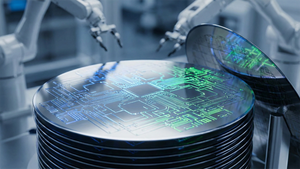
The relentless pursuit of artificial intelligence (AI) has thrust the semiconductor industry into an unprecedented era of growth, but this rapid expansion casts an alarming environmental shadow, demanding immediate global attention. The manufacturing of AI chips, particularly advanced GPUs and specialized accelerators, is extraordinarily resource-intensive, pushing critical environmental boundaries in energy consumption, carbon emissions, water usage, and electronic waste generation. This escalating environmental footprint poses an immediate and profound challenge to global climate goals and the sustainability of vital natural resources.
The immediate significance of these growing concerns cannot be overstated. AI chip manufacturing and the data centers that power them are rapidly becoming major contributors to global carbon emissions, with CO2 emissions from AI accelerators alone projected to surge by 300% between 2025 and 2029. The electricity required for AI chip manufacturing soared over 350% year-on-year from 2023 to 2024, with projections suggesting this demand could surpass the total electricity consumption of entire nations like Ireland by 2030. Beyond energy, the industry's colossal demand for ultra-pure water—with large semiconductor plants consuming millions of gallons daily and AI data centers using up to 19 million gallons per day—is placing immense strain on freshwater resources, a problem exacerbated by climate change and the siting of new facilities in high water-risk areas. This interwoven crisis of resource depletion and pollution, coupled with the rising tide of hazardous e-waste from frequent hardware upgrades, makes sustainable semiconductor manufacturing not merely an ethical imperative, but a strategic necessity for the future of both technology and the planet.
The Deepening Footprint: Technical Realities of AI Chip Production
The rapid advancement and widespread adoption of AI are placing an unprecedented environmental burden on the planet, primarily due to the resource-intensive nature of AI chip manufacturing and operation. This impact is multifaceted, encompassing significant energy and water consumption, the use of hazardous chemicals, the generation of electronic waste, and reliance on environmentally damaging rare earth mineral extraction.
Semiconductor fabrication, particularly for advanced AI chips, is one of the most resource-intensive industries. The production of integrated circuits (ICs) alone contributes to 185 million tons of CO₂ equivalent emissions annually. Producing a single square centimeter of wafer can consume 100-150 kWh of electricity, involving extreme temperatures and complex lithography tools. A single large semiconductor fabrication plant (fab) can consume 100-200 MW of power, comparable to a small city's electricity needs, or roughly 80,000 U.S. homes. For instance, Taiwan Semiconductor Manufacturing Company (TSMC) (NYSE: TSM), a leading AI chip manufacturer, consumed 22,400 GWh of energy in 2022, with purchased electricity accounting for about 94%. Greenpeace research indicates that electricity consumption linked to AI hardware manufacturing increased by over 350% between 2023 and 2024, projected to rise 170-fold in the next five years, potentially exceeding Ireland's total annual power consumption. Much of this manufacturing is concentrated in East Asia, where power grids heavily rely on fossil fuels, exacerbating greenhouse gas emissions. Beyond energy, the industry's colossal demand for ultra-pure water—with large semiconductor plants consuming millions of gallons daily and AI data centers using up to 19 million gallons per day—is placing immense strain on freshwater resources.
Several technical advancements in AI chips are exacerbating their environmental footprint. The relentless push towards smaller process nodes (e.g., 5nm, 3nm, 2nm, and beyond) requires more sophisticated and energy-intensive equipment and increasingly complex manufacturing steps. For instance, advanced N2 logic nodes generate approximately 1,600 kg CO₂eq per wafer, with lithography and dry etch contributing nearly 40% of total emissions. The energy demands of advanced exposure tools like Extreme Ultraviolet (EUV) lithography are particularly high, with systems consuming up to 2.5 MW. Modern AI accelerators, such as GPUs, are significantly more complex and often multiple times larger than their consumer electronics counterparts. This complexity drives higher silicon area requirements and more intricate manufacturing processes, directly translating to increased carbon emissions and water usage during fabrication. For example, manufacturing the ICs for one Advanced Micro Devices (AMD) (NASDAQ: AMD) MI300X chip, with over 40 cm² of silicon, requires more than 360 gallons of water and produces more carbon emissions compared to an NVIDIA (NASDAQ: NVDA) Blackwell chip, which uses just under 20 cm² of silicon.
The environmental impact of AI chip manufacturing differs from that of older or general-purpose computing in several key ways. AI chips, especially GPUs, inherently consume more energy and emit more heat than traditional Central Processing Unit (CPU) chips. The fabrication process for a powerful GPU or specialized AI accelerator is considerably more complex and resource-intensive than that for a simpler CPU, translating to higher energy, water, and chemical demands per chip. Furthermore, the rapid pace of AI development means that AI-specific hardware becomes obsolete much faster (2-3 years) compared to general-purpose servers (5-7 years). This accelerated replacement cycle leads to a growing problem of specialized electronic waste, which is difficult to recycle due to complex materials. The "AI Supercycle" and the insatiable demand for computational power are driving an unprecedented surge in chip production, magnifying the existing environmental concerns of the semiconductor industry.
There is a growing awareness and concern within the AI research community and among industry experts regarding the environmental impact of AI chips. Experts are increasingly vocal about the need for immediate action, emphasizing the urgency of developing and implementing sustainable practices across the entire AI hardware lifecycle. Major chipmakers like Samsung (KRX: 005930) and Intel (NASDAQ: INTC) are prioritizing sustainability, committing to ambitious net-zero emissions goals, and investing in sustainable technologies such as renewable energy for fabs and advanced water recycling systems. Microsoft (NASDAQ: MSFT) has announced an agreement to use 100% of the electricity from the Three Mile Island nuclear power plant for 20 years to power its operations. Researchers are exploring strategies to mitigate the environmental footprint, including optimizing AI models for fewer resources, developing domain-specific AI models, and creating more energy-efficient hardware like neuromorphic chips and optical processors.
Corporate Crossroads: Navigating the Green AI Imperative
The increasing scrutiny of the environmental impact of semiconductor manufacturing for AI chips is profoundly reshaping the strategies and competitive landscape for AI companies, tech giants, and startups alike. This growing concern stems from the significant energy, water, and material consumption associated with chip production, especially for advanced AI accelerators. Companies slow to adapt face increasing regulatory and market pressures, potentially diminishing their influence within the AI ecosystem.
The growing concerns about environmental impact create significant opportunities for companies that prioritize sustainable practices and develop innovative green technologies. This includes firms developing energy-efficient chip designs, focusing on "performance per watt" as a critical metric. Companies like Alphabet (Google) (NASDAQ: GOOGL), with its Ironwood TPU, are demonstrating significant power efficiency improvements. Neuromorphic computing, pioneered by Intel (NASDAQ: INTC) with its Loihi chips, and advanced architectures from companies like Arm Holdings (NASDAQ: ARM) are also gaining an advantage. Chip manufacturers like TSMC (NYSE: TSM) are signing massive renewable energy power purchase agreements, and GlobalFoundries (NASDAQ: GFS) aims for 100% carbon-neutral power by 2050. Tech giants like Google (NASDAQ: GOOGL), Amazon (NASDAQ: AMZN), and Microsoft (NASDAQ: MSFT) are heavily investing in renewable energy projects to power their data centers and AI operations. Startups are also emerging with innovative green AI hardware, such as Vertical Semiconductor (developing Vertical Gallium Nitride (GaN) AI chips), Positron and Groq (focusing on optimized inference), and Nexalus (developing systems to cool and reuse thermal energy).
The shift towards green AI chips is fundamentally altering competitive dynamics. "Performance per watt" is no longer secondary to performance but a crucial design principle, putting pressure on dominant players like NVIDIA (NASDAQ: NVDA), whose GPUs, while powerful, are often described as power-hungry. Greenpeace specifically ranks NVIDIA low on supply chain decarbonization commitments, while Apple (NASDAQ: AAPL) has achieved a higher rank for its supply chain decarbonization efforts. Tech giants like Google (NASDAQ: GOOGL), Amazon (NASDAQ: AMZN), and Microsoft (NASDAQ: MSFT) are heavily investing in custom silicon, such as Google's TPUs and Microsoft's Azure Maia 100, to optimize chips for both performance and energy efficiency, reducing reliance on third-party providers and gaining more control over their environmental footprint. This drive for sustainability will lead to several disruptions, including the accelerated obsolescence of less energy-efficient chip designs and a significant push for new, eco-friendly materials and manufacturing processes.
Companies that proactively embrace green AI chips and sustainable manufacturing will gain substantial market positioning and strategic advantages. Optimizing resource use and improving energy efficiency can lead to significant operational cost reductions. Adopting sustainable practices strengthens customer loyalty, enhances brand image, and meets increasing stakeholder demands for responsible technology, improving ESG credentials. The "sustainable-performance" paradigm opens new markets in areas like edge AI and hyper-efficient cloud networks. Furthermore, circular economy solutions can reduce dependency on single-source suppliers and mitigate raw material constraints, enhancing geopolitical stability. Sustainability is becoming a powerful competitive differentiator, influencing supply chain decisions and securing preferred provider status with major fabs and OEMs.
A Broader Canvas: AI's Environmental Intersections
The growing concerns about the environmental impact of semiconductor manufacturing for AI chips carry significant wider implications, deeply embedding themselves within the broader AI landscape, global sustainability trends, and presenting novel challenges compared to previous technological advancements. The current "AI race" is a major driving force behind the escalating demand for high-performance AI chips, leading to an unprecedented expansion of semiconductor manufacturing and data center infrastructure.
However, alongside this rapid growth, there is an emerging trend towards "design for sustainability" within the AI industry. This involves integrating eco-friendly practices throughout the chip lifecycle, from design to disposal, and leveraging AI itself to optimize manufacturing processes, reduce resource consumption, and enhance energy efficiency in chipmaking. Research into novel computing paradigms like neuromorphic and analog AI, which mimic the brain's energy efficiency, also represents a significant trend aimed at reducing power consumption.
The environmental impacts of AI chip manufacturing and operation are multifaceted and substantial. The production of AI chips is incredibly energy-intensive, with electricity consumption for manufacturing alone soaring over 350% year-on-year from 2023 to 2024. These chips are predominantly manufactured in regions reliant on fossil fuels, exacerbating greenhouse gas emissions. Beyond manufacturing, AI models require immense computational power for training and inference, leading to a rapidly growing carbon footprint from data centers. Data centers already account for approximately 1% of global energy demand, with projections indicating this could rise to 8% by 2030, and AI chips could consume 1.5% of global electricity by 2029. Training a single AI model can produce emissions equivalent to 300 transcontinental flights or five cars over their lifetime. Semiconductor manufacturing also demands vast quantities of ultra-pure water for cleaning silicon wafers and cooling systems, raising concerns in regions facing water scarcity. AI hardware components necessitate raw materials, including rare earth metals, whose extraction contributes to environmental degradation. The rapid innovation cycle in AI technology leads to quicker obsolescence of hardware, contributing to the growing global e-waste problem.
The escalating environmental footprint of AI chips raises several critical concerns. The increasing energy and water demands, coupled with greenhouse gas emissions, directly conflict with national and international decarbonization targets. There's a risk of a "rebound effect," where the sheer growth in demand for AI computing power could offset any efficiency gains. Current methods for reporting greenhouse gas emissions from AI chip manufacturing may significantly underrepresent the true climate footprint, making it difficult to assess and mitigate the full impact. The pursuit of advanced AI at any environmental cost can also lead to ethical dilemmas, prioritizing technological progress and economic growth over environmental protection.
The current concerns about AI chip manufacturing represent a significant escalation compared to previous AI milestones. Earlier AI advancements did not demand resources at the unprecedented scale seen with modern large language models and generative AI. Training these complex models requires thousands of GPUs running continuously for months, a level of intensity far beyond what was typical for previous AI systems. For example, a single query to ChatGPT can consume approximately 10 times more energy than a standard Google search. The rapid evolution of AI technology leads to a faster turnover of specialized hardware compared to previous computing eras, accelerating the e-waste problem. Historically, energy concerns in computing were often consumer-driven; now, the emphasis has shifted dramatically to the overarching environmental sustainability and carbon footprint reduction of AI models themselves.
The Horizon: Charting a Sustainable Path for AI Chips
The rapid proliferation of AI is ushering in an era of unprecedented technological advancement, yet it presents a significant environmental challenge, particularly concerning the manufacturing of its foundational components: AI chips. However, future developments aim to mitigate these impacts through a combination of technological innovation, process optimization, and a strategic shift towards sustainability.
In the near future (1-5 years), the semiconductor industry is set to intensify efforts to reduce the environmental footprint of AI chip manufacturing. Key strategies include enhancing advanced gas abatement techniques and increasingly adopting less environmentally harmful gases. There will be an accelerated integration of renewable energy sources into manufacturing operations, with more facilities transitioning to green energy. A stronger emphasis will be placed on sourcing sustainable materials and implementing green chemistry principles. AI and machine learning will continue to optimize chip designs for energy efficiency, leading to specialized AI accelerators that offer higher performance per watt and innovations in 3D-IC technology. AI will also be deeply embedded in manufacturing processes for continuous optimization, enabling precise control and predictive maintenance. Stricter regulations and widespread deployment of advanced water recycling and treatment systems are also expected.
Looking further ahead (beyond 5 years), the industry envisions more transformative changes. A complete transition towards a circular economy for AI hardware is anticipated, emphasizing the recycling, reusing, and repurposing of materials. Further development and widespread adoption of advanced abatement systems, potentially incorporating technologies like direct air capture (DAC), will become commonplace. Given the immense power demands of AI, nuclear energy is emerging as a long-term, environmentally friendly solution, with major tech companies already investing in this space. A significant shift towards inherently energy-efficient AI architectures such as neuromorphic computing is expected. Advanced materials like silicon carbide (SiC) and gallium nitride (GaN) are also being explored for AI chips.
AI itself is playing a dual role—both driving the demand for more powerful chips and offering solutions for a more sustainable future. AI-powered Electronic Design Automation (EDA) tools will revolutionize chip design by automating tasks, predicting optimal layouts, and reducing power leakage. AI will enhance semiconductor manufacturing efficiency through predictive analytics, real-time process optimization, and defect detection. AI-driven autonomous experimentation will accelerate the development of new semiconductor materials. Sustainably manufactured AI chips will power hyper-efficient cloud and 5G networks, extend battery life in devices, and drive innovation in various sectors.
Despite these future developments, significant challenges persist. AI chip production is extraordinarily energy-intensive, consuming vast amounts of electricity, ultra-pure water, and raw materials. The energy consumption for AI chip manufacturing alone soared over 350% from 2023 to 2024, with global emissions from this usage quadrupling. Much of AI chip manufacturing is concentrated in East Asia, where power grids heavily rely on fossil fuels. The industry relies on hazardous chemicals that contribute to air and water pollution, and the burgeoning e-waste problem from advanced components is a growing concern. The complexity and cost of manufacturing advanced AI chips, along with complex global supply chains and geopolitical factors, also pose hurdles. Experts predict a complex but determined path towards sustainability, with continued short-term emission increases but intensified net-zero commitments and a stronger emphasis on "performance per watt." Energy generation may become the most significant constraint on future AI expansion, prompting companies to explore long-term solutions such as nuclear and fusion energy.
The Green Silicon Imperative: A Call to Action
The rapid advancement of Artificial Intelligence (AI) is undeniably transformative, yet it comes with a significant and escalating environmental cost, primarily stemming from the manufacturing of its specialized semiconductor chips. This intensive production process, coupled with the energy demands of the AI systems themselves, presents a formidable challenge to global sustainability efforts.
Key takeaways highlight the severe, multi-faceted environmental impact: soaring energy consumption and carbon emissions, prodigious water usage, hazardous chemical use and waste generation, and a growing electronic waste problem. The production of AI chips, especially advanced GPUs, is extremely energy-intensive, often multiple times larger and more complex than standard consumer electronics. This has led to a more than tripling of electricity consumption for AI chip production between 2023 and 2024, resulting in a fourfold increase in CO2 emissions. Much of this manufacturing is concentrated in East Asia, where fossil fuels still dominate electricity grids. The industry also demands vast quantities of ultrapure water, with facilities consuming millions of gallons daily, and utilizes numerous hazardous chemicals, contributing to pollution and persistent environmental contaminants like PFAS. The rapid obsolescence of AI hardware further exacerbates the e-waste crisis.
This environmental footprint represents a critical juncture in AI history. Historically, AI development focused on computational power and algorithms, largely overlooking environmental costs. However, the escalating impact now poses a fundamental challenge to AI's long-term sustainability and public acceptance. This "paradox of progress" — where AI fuels demand for resources while also offering solutions — is transforming sustainability from an optional concern into a strategic necessity. Failure to address these issues risks undermining global climate goals and straining vital natural resources, making sustainable AI not just an ethical imperative but a strategic necessity for the future of technology.
The long-term impact will be determined by how effectively the industry and policymakers respond. Without aggressive intervention, we face exacerbated climate change, resource depletion, widespread pollution, and an escalating e-waste crisis. However, there is a "glimmer of hope" for a "green revolution" in silicon through concerted, collaborative efforts. This involves decoupling growth from environmental impact through energy-efficient chip design, advanced cooling, and sustainable manufacturing. A fundamental shift to 100% renewable energy for both manufacturing and data centers is crucial, alongside embracing circular economy principles, green chemistry, and robust policy and regulation. The long-term vision is a more resilient, resource-efficient, and ethically sound AI ecosystem, where environmental responsibility is intrinsically linked with innovation, contributing to global net-zero goals.
In the coming weeks and months, watch for increased net-zero commitments and renewable energy procurement from major semiconductor companies and AI tech giants, especially in East Asia. Look for technological innovations in energy-efficient AI architectures (e.g., neuromorphic computing) and improved data center cooling solutions. Monitor legislative and regulatory actions, particularly from regions like the EU and the US, which may impose stricter environmental standards. Pay attention to efforts to increase supply chain transparency and collaboration, and observe advancements in water management and the reduction of hazardous chemicals like PFAS. The coming months will reveal whether the urgent calls for sustainability translate into tangible, widespread changes across the AI chip manufacturing landscape, or if the relentless pursuit of computing power continues to outpace environmental stewardship.
This content is intended for informational purposes only and represents analysis of current AI developments.
TokenRing AI delivers enterprise-grade solutions for multi-agent AI workflow orchestration, AI-powered development tools, and seamless remote collaboration platforms.
For more information, visit https://www.tokenring.ai/.






